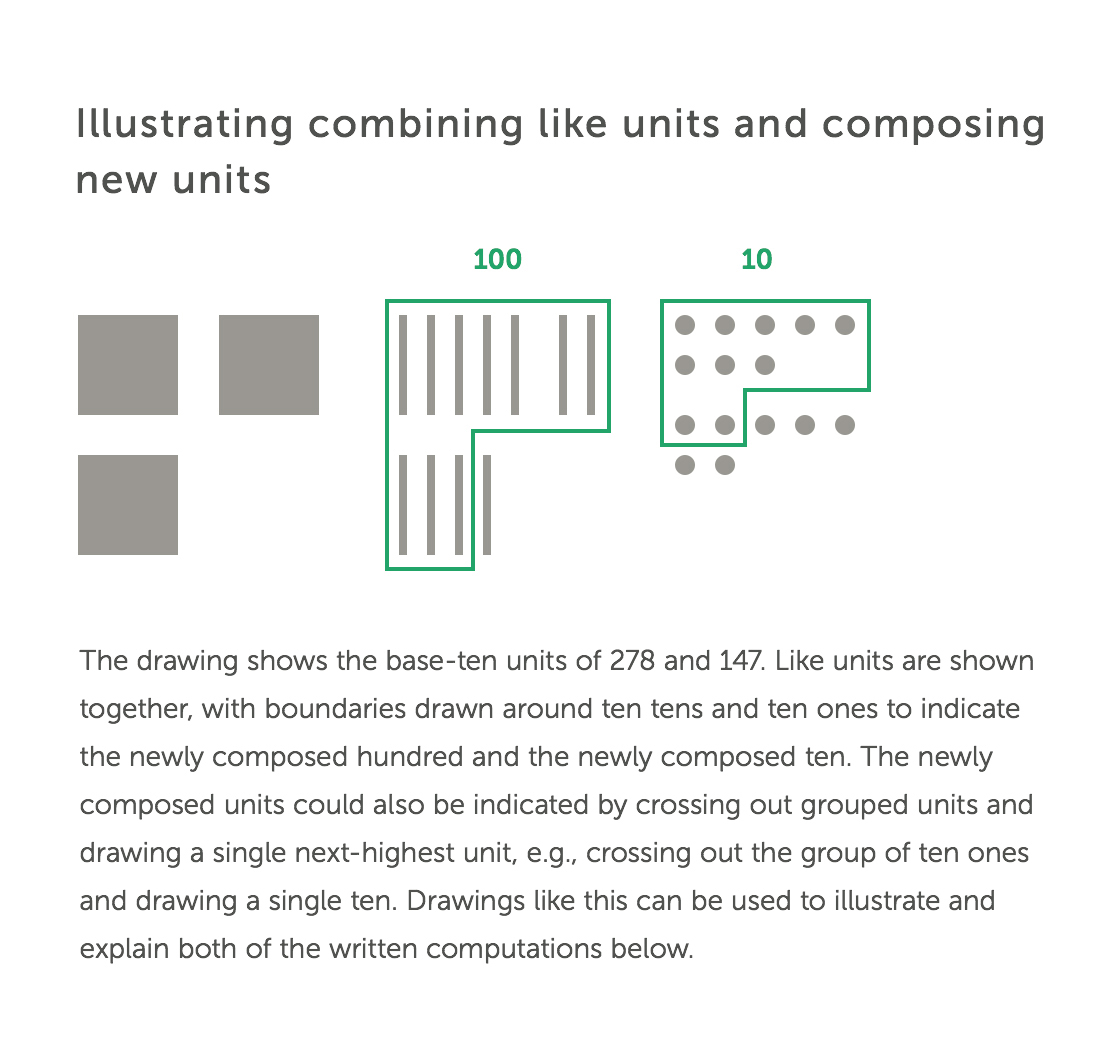Number And Operations In Base Ten
Understand Place Value.
2.NBT.A.1
Understand that the three digits of a three-digit number represent amounts of hundreds, tens, and ones; e.g., 706 equals 7 hundreds, 0 tens, and 6 ones. Understand the following as special cases:
Number And Operations In Base Ten
Use Place Value Understanding And Properties Of Operations To Add And Subtract.
2.NBT.B.8
Mentally add 10 or 100 to a given number 100–900, and mentally subtract 10 or 100 from a given number 100–900.
Number And Operations In Base Ten
Use Place Value Understanding And Properties Of Operations To Add And Subtract.
2.NBT.B.9
Explain why addition and subtraction strategies work, using place value and the properties of operations.*
*Explanations may be supported by drawings or objects.
Number And Operations In Base Ten
Use Place Value Understanding And Properties Of Operations To Add And Subtract.
2.NBT.B.7
Add and subtract within 1000, using concrete models or drawings and strategies based on place value, properties of operations, and/or the relationship between addition and subtraction; relate the strategy to a written method. Understand that in adding or subtracting three- digit numbers, one adds or subtracts hundreds and hundreds, tens and tens, ones and ones; and sometimes it is necessary to compose or decompose tens or hundreds.
Example Task
2.NBT How Many Days Until Summer Vacation?
Task
Materials
* Paper * Pencil * Hundreds board * Base-ten blocks
Actions
Pose this problem to the children: We are in school 180 days. Today is the 124th day of school. How many more days until we are out of school for summer vacation? Explain how you know.
Solutions
Solution: 3
Using base-ten blocks:
Start with 1 hundred, 8 tens, 0 ones. We can’t take away 4 ones from 0 ones so we have to break a ten into 10 ones. I now have 7 tens 10 ones. Now we can subtract using the take-away model.
10 - 4 = 6.
70 - 20 = 50.
100 - 100 = 0.
So there are 56 days of school before we get out for summer vacation. Here is a picturing showing the 100s, 10s and 1s.

Solution: 1
Count by ones to the next decade: 125, 126, 127, 128, 129, 130. So we have added 6.
Then count by tens: 140, 150, 160, 170, 180, which makes 5 tens or 50.
Since 50 + 6 = 56, there are 56 days left before we get out of school for summer vacation.
Students can use the 100s board or draw an "empty number line" to help them count.

Solution: 2
Count by tens from 124: 134, 144, 154, 164, 174, 184. That is 6 tens or 60.
But 184 is too big so count back to 180, which is 4.
Subtract 4 from 60 to get 56. We have 56 days of school left.

Progressions
Drawings can support students in explaining [methods for addition within 1000]. The drawing [below] shows addents decomposed into their base-ten units (here, hundreds, tens, and ones), with the tens and hundreds by quick drawings. These quick drawings show each hundred as a single unit rather than ten tens. The putting together of like quick drawings illustrates adding adding like units as specified in 2.NBT.[B.]7: add ones to ones, tens to tens, and hundreds to hundreds. The drawing also shows newly composed units.
[T]he major focus for addition within 1000 needs to be on methods such those... [below that] are sufficient for fluency (e.g., recording new units in one row).


Please reference pages 9 and 10 in the Progression document
Focus
Number And Operations In Base Ten
Use Place Value Understanding And Properties Of Operations To Perform Multi-Digit Arithmetic.*
*A range of algorithms may be used.
3.NBT.A.2
Fluently add and subtract within 1000 using strategies and algorithms based on place value, properties of operations, and/or the relationship between addition and subtraction.
*A range of algorithms may be used.
Number And Operations In Base Ten
Use Place Value Understanding And Properties Of Operations To Add And Subtract.
2.NBT.B.6
Add up to four two-digit numbers using strategies based on place value and properties of operations.